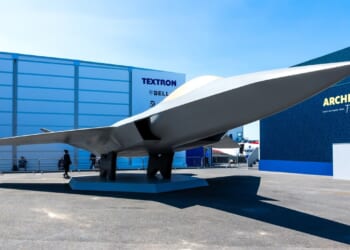Developed by North American Aviation (NAA), the A3J-1 Vigilante, later redesignated as the A-5 in 1962, was one of the most ambitious warplanes developed during the Cold War. A carrier-based, supersonic bomber, the Vigilante was intended to deliver nuclear hellfire with unprecedented speed and precision, succeeding the Douglas A-3 Skywarrior in the US Navy’s arsenal.
The A3J-1 Vigilante’s Specs
- Year Introduced: 1961
- Number Built: 167
- Length: 76 ft 6 in (23.32 m)
- Height: 19 ft 5 in (5.91 m)
- Wingspan: 53 ft 0 in (16.16 m)
- Weight:
- Empty: 32,783 lb (14,870 kg)
- Standard conditions: 47,631 lb (21,605 kg)
- Maximum takeoff weight: 63,085 lb (28,615 kg)
- Engines: 2 × General Electric J79-GE-8 after-burning turbojet engines, 10,900 lbf (48 kN) thrust each dry
- Top Speed: 1,322 mph (2,128 km/h) at 40,000 ft (12,000 m)
- Range: 1,121 mi (1,804 km) combat range
- Service Ceiling: 52,100 ft (15,900 m)
- Loadout: 1 nuclear bomb in cargo bay; 2 smaller bombs on external hardpoints;
- Aircrew: 2
About the A3J-1 Vigilante
Introduced in June 1961, the Vigilante embodied the technological optimism of the 1950s-60s, pushing the boundaries of aviation with Mach 2 capabilities, innovative avionics, and a unique weapons delivery system.
The origins of the A3J-1 track back to 1953, when NAA initiated a private venture known as the North American General Purpose Attack Weapon (NAGPAW). This concept evolved from the canceled XF-108 Rapier interceptor project, repurposed for naval use as a long-range, all-weather strike bomber capable of supersonic speeds.
In July 1955, the US Navy awarded an initial design contract, followed by a full development agreement in September 1956 for two prototypes. The first XA3J-1 prototype took flight on August 31, 1958, from Columbus, Ohio, showcasing NAA’s expertise in high-performance aircraft. Early testing revealed the aircraft’s versatility, from high-altitude dashes exceeding Mach 2 to low-level terrain-hugging approaches for evading radar.
By 1961, the Vigilante entered service with Heavy Attack Squadron Three (VAH-3) at Naval Air Station in Sanford, Fla., marking the Navy’s first Mach-2 capable bomber. Production ran from 1956 to 1963, yielding 57 A-5A models, though the design’s complexity often strained resources.
Understanding the Vigilante
The design of the A3J-1 was revolutionary for carrier operations. It featured a sleek, aerodynamic fuselage with a long nose, sharply swept shoulder-mounted wings, and a tall vertical stabilizer to minimize radar cross-section. The aircraft lacked traditional ailerons, relying instead on spoilers and differential deflection of its all-moving horizontal stabilizers for roll control, enhanced by a yaw augmentation system. Materials innovation was key: aluminum-lithium alloy for wing skins, titanium for heat-prone areas, and a gold-coated bomb bay to deflect thermal energy from nuclear payloads.
Powered by two General Electric J79-GE-8 turbojet engines, each delivering 17,000 pounds of thrust with afterburner, the Vigilante could achieve speeds up to 1,322 miles per hour (Mach 2) at 40,000 feet. Its most distinctive feature was the linear bomb bay—a tube between the engines housing a nuclear weapon and disposable fuel tanks in a “stores train” configuration, ejected rearward for high-speed delivery to reduce vulnerability.
Avionics included the AN/ASB-12 bombing and navigation system with inertial platforms, radar, and computers for all-weather targeting, plus electronic countermeasures for penetration missions. The two-crew setup sat in tandem under a clamshell canopy, with early fly-by-wire controls and a heads-up display enhancing situational awareness. Armament centered on internal nuclear bombs, like the Mark 27 or the B43, supplemented by conventional ordnance on external hardpoints. These specs made it the largest and heaviest bird to routinely operate from carriers, demanding precise handling during launches and recoveries.
Boasting a combat range of 974 nautical miles—extendable via air refueling or external tanks on wing pylons—the plane had a service ceiling of 52,100 feet with an 8,000 feet-per-minute climb rate.
The Vigilante’s Short but Impressive Service Life
Despite its unique design and speed, the Vigilante’s role was short-lived. Deployed initially for nuclear deterrence, it faced significant reliability issues with its advanced systems, requiring costly maintenance.
By 1963, the Navy’s shift toward submarine-launched missiles diminished the need for carrier-based strategic nuclear bombers, prompting the conversion of many A-5As to the RA-5C reconnaissance variant, equipped with side-looking airborne radar, infrared sensors, and cameras.
During the Vietnam War, RA-5Cs flew high-risk missions from carriers like the USS Saratoga, providing critical intelligence for troops on the ground but suffering heavy losses—18 to enemy fire and nine to accidents. A3J-1 losses led the Navy to request more of the aircraft from NAA, leading to its resumed production from 1968-70. The last Vigilante left service in November 1979, as postwar budget cuts and high costs sealed its fate.
The A3J-1 Vigilante’s legacy, regardless of its complicated design flaws and maintenance issues, remains a testament to the innovativeness of the early Cold War era US military. This warbird set numerous records, including a 91,450-foot altitude record—with its payload—in 1961. It also influenced the design of the excellent F-111 Aardvark. Though its bomber mission was ultimately curtailed, its reconnaissance contributions in Vietnam highlighted adaptability.
Today, surviving examples in museums remind Americans of an era where speed and technology redefined naval aviation, even if the Vigilante’s full potential remained partially unrealized.
About the Author: Brandon J. Weichert
Brandon J. Weichert, a Senior National Security Editor at The National Interest as well as a contributor at Popular Mechanics, who consults regularly with various government institutions and private organizations on geopolitical issues. Weichert’s writings have appeared in multiple publications, including the Washington Times, National Review, The American Spectator, MSN, the Asia Times, and countless others. His books include Winning Space: How America Remains a Superpower, Biohacked: China’s Race to Control Life, and The Shadow War: Iran’s Quest for Supremacy. His newest book, A Disaster of Our Own Making: How the West Lost Ukraine is available for purchase wherever books are sold. He can be followed via Twitter @WeTheBrandon.
Image: Wikimedia Commons.
















